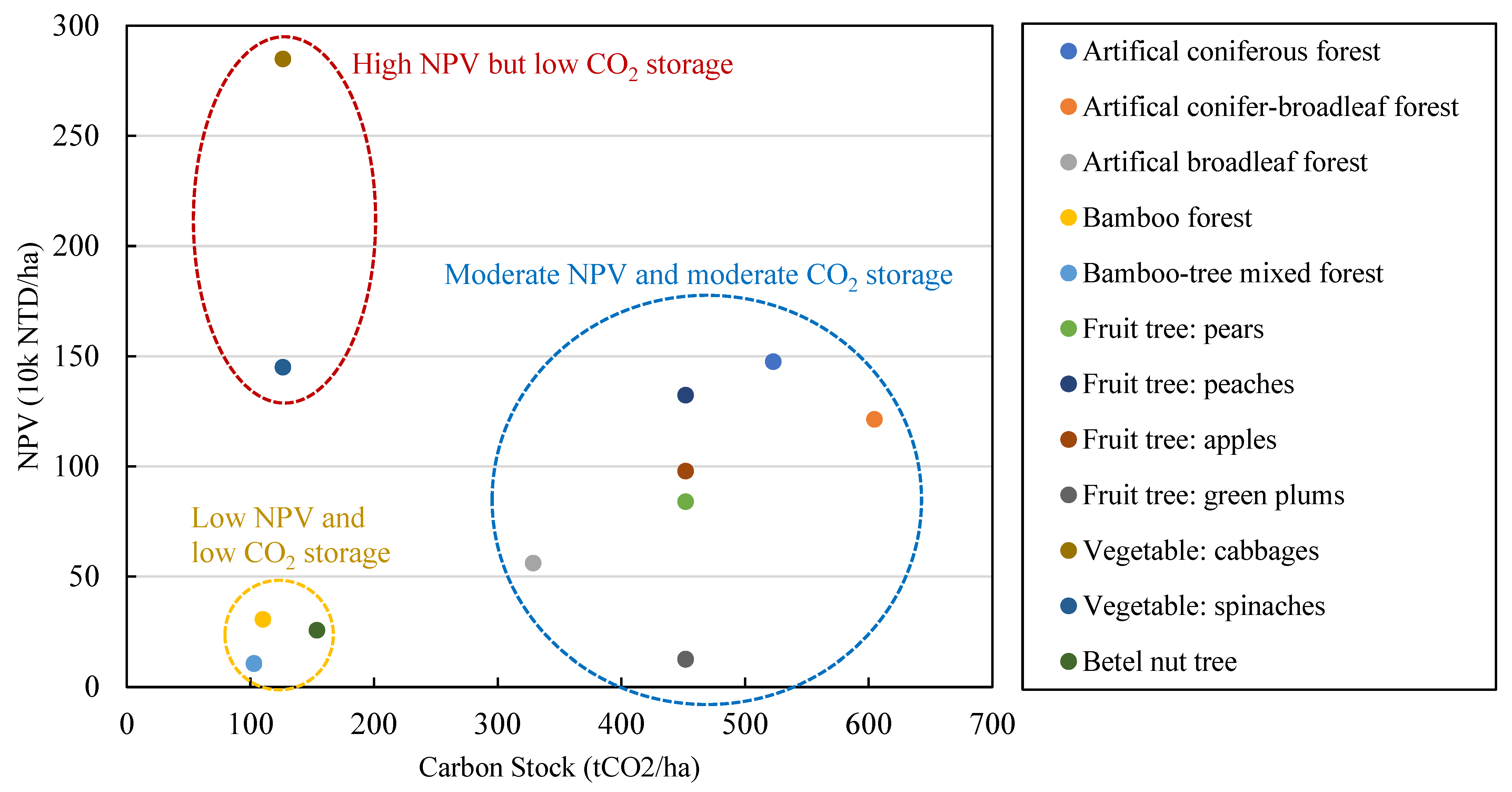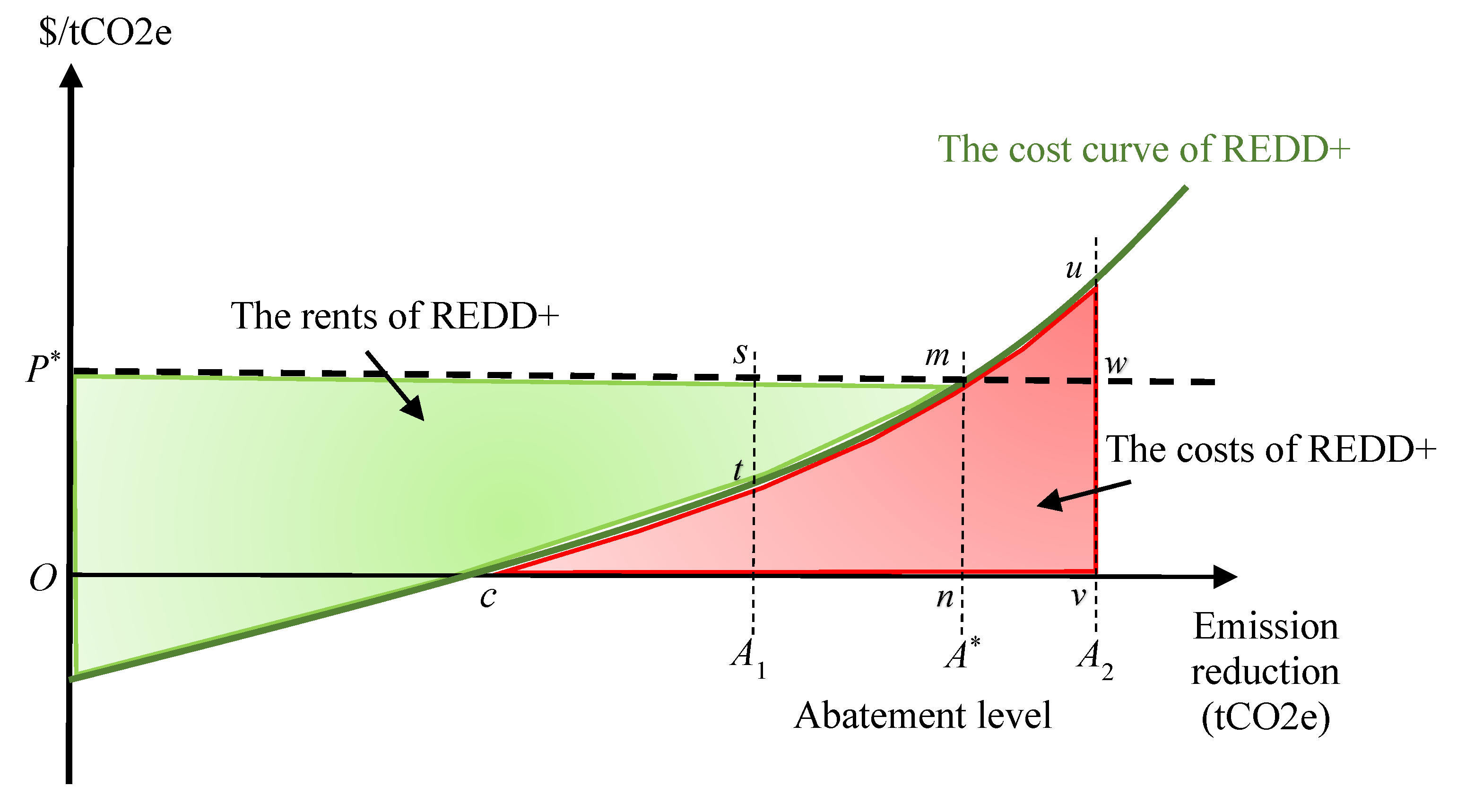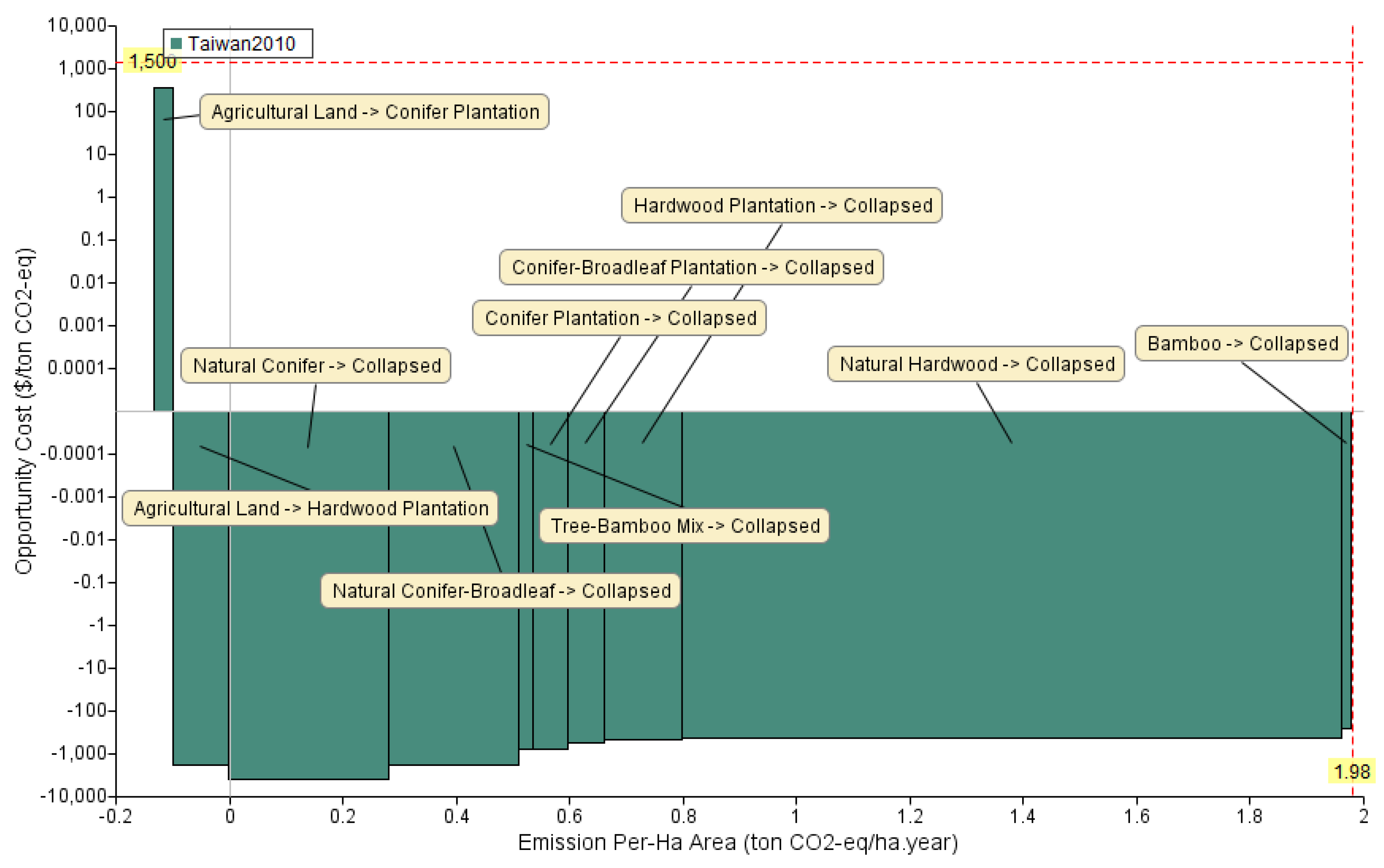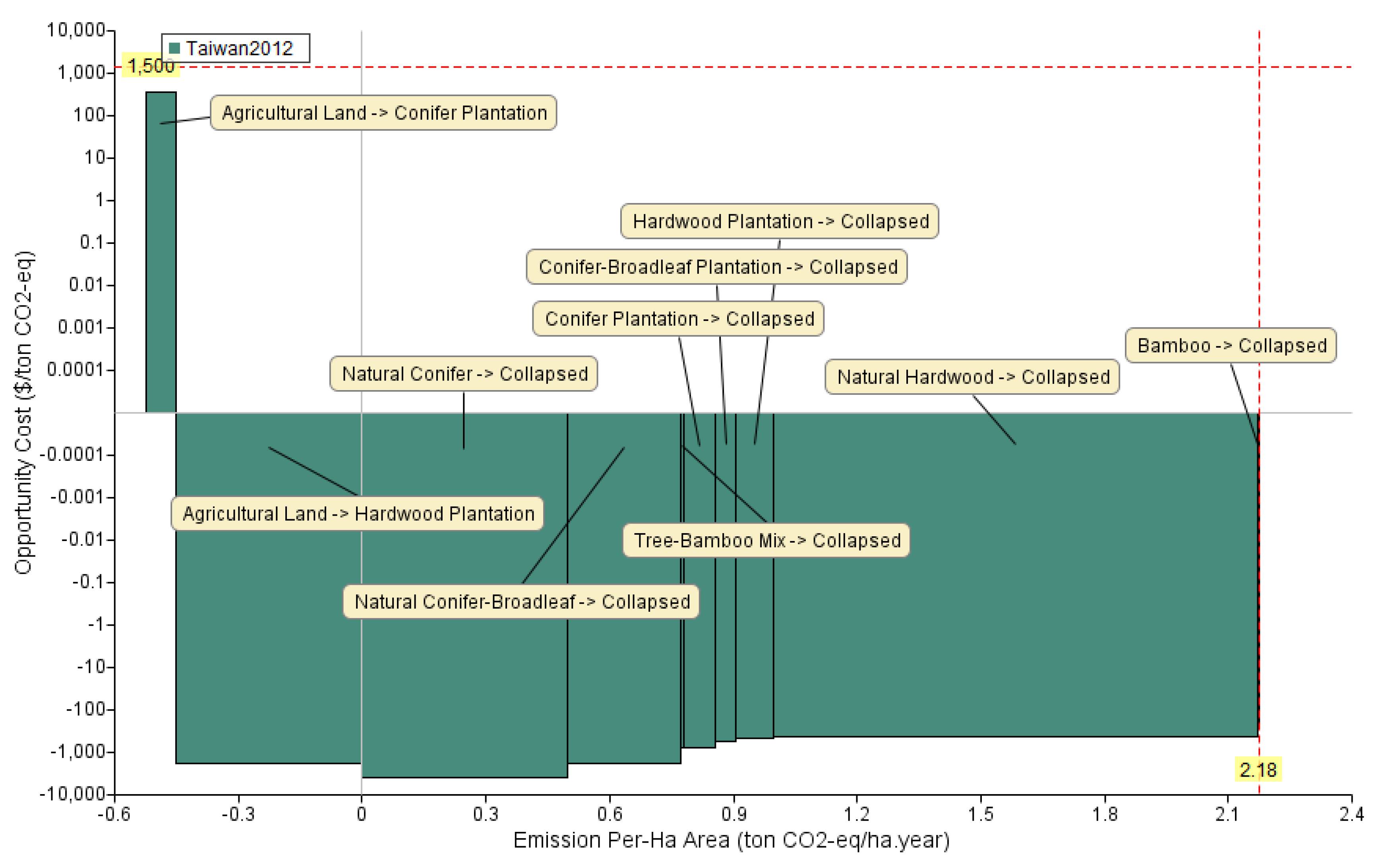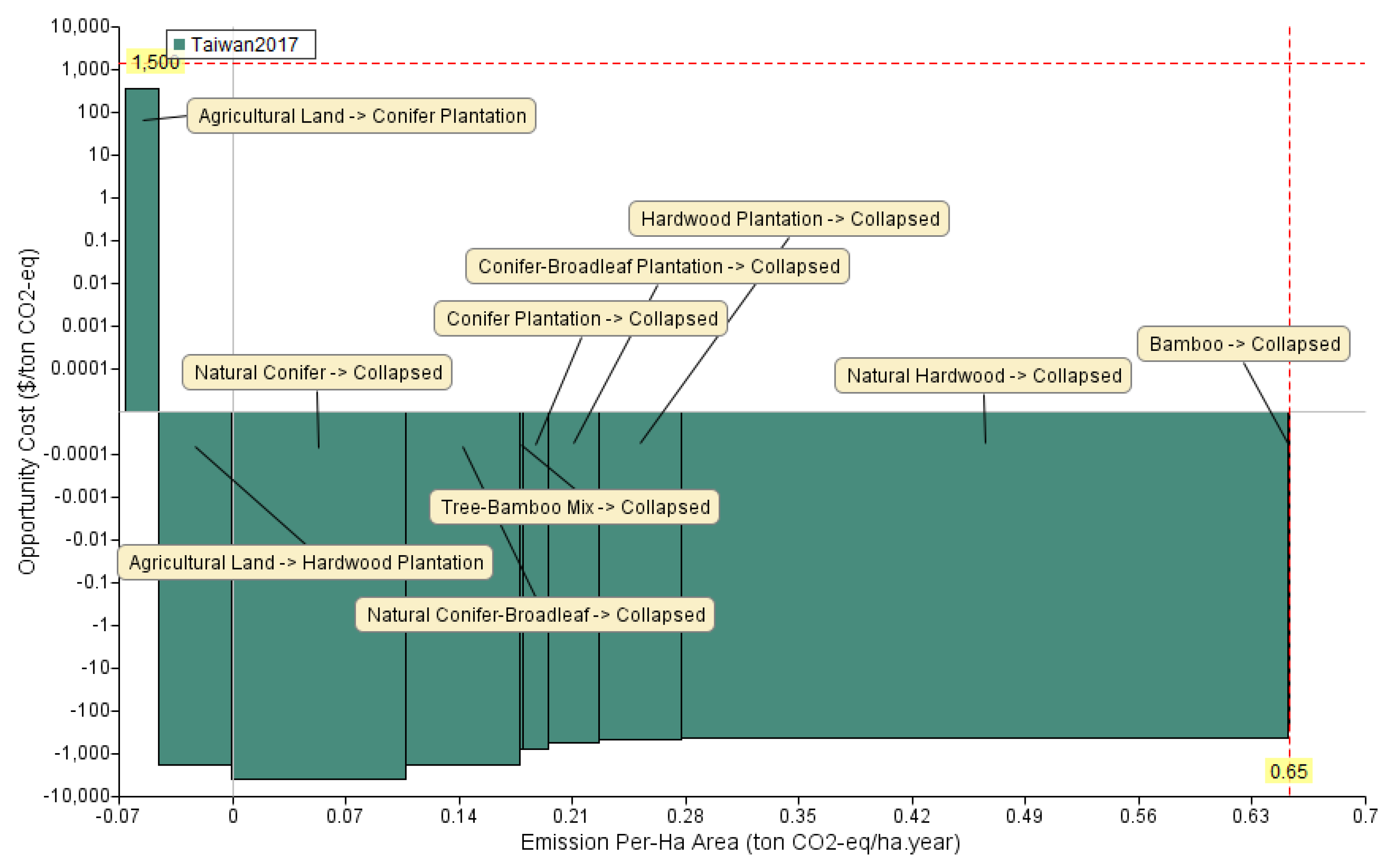1. Introduction
During 1951–2010, greenhouse gases increased the average global surface temperature by 0.5 °C to 1.3 °C [
1]. Among them, CO
2 is the major human-made greenhouse gas. Between 1980 and 2011, the average annual increase of global CO
2 concentration was 1.7 ppm [
2]. After emissions generated by energy consumption, the second major causes of greenhouse gas emissions are deforestation and forest degradation, which account for 17% of the global human-made CO
2 emissions [
3,
4,
5].
Compared with conventional approaches for reducing carbon emissions, the strategies for reducing emissions from deforestation and forest degradation (REDD) can address climate change issues with greatly reduced costs [
6]. As the extension of REDD, the REDD+ strategies additionally include forest protection, carbon storage, and sustainable forest management. Both the REDD and REDD+ strategies are recognized as fundamental strategies for mitigating climate change by the United Nations Framework Convention on Climate Change [
7].
Many countries have realized that the REDD and REDD+ strategies contribute considerable financial benefits [
8]. In 2011, the value of global REDD projects exceeded USD 87 million and that of afforestation/reforestation (A/R) projects reached USD 65 million, whereas the trading volumes of REDD and A/R projects were 7.3 MtCO2e and 7.6 MtCO2e, respectively [
9]. In the same year, the global carbon market grew by 11% in value, to USD 176 billion [
10].
The REDD+ strategies are a solution for protecting tropical forests [
11] and an essential and proactive incentive approach for carbon emission reduction and sustainable forest management [
12]. A study on a dry forest in southwestern Madagascar indicated that potential REDD+ payments can provide sufficient financial incentives to protect forests with relatively low opportunity costs of carbon storage [
13]. However, the benefits of REDD+ can only be received through meaningful investments, with the benefits surpassing the costs. Therefore, governments tend to evaluate the costs and benefits of REDD+ investments before making decisions. White and Minang [
14] divided costs into the following three categories: opportunity cost, implementation cost, and transaction cost. They concluded that the opportunity cost is the most crucial part of the benefits of REDD+ because the opportunity cost reveals the influence of deforestation, and facilitates evaluations of the amount of fair compensation for land-use change.
Pagiola et al. [
15] implied that when a country reduces its forest loss rate to fulfill the REDD obligations, the opportunity cost is the most essential cost among all of the incurred costs. In fact, the opportunity cost indicates the highest net income of the alternative land use regarding deforested areas [
16]. Guo and Gong [
17] used a partial equilibrium model based on intertemporal optimization to examine the potential and the cost of promoting forest carbon sequestration through taxes/subsidies to land owners for reducing/increasing carbon storage in their forests. Yang and Li [
18] estimated the opportunity cost for REDD+ using the net present value (NPV), and discovered that the estimated opportunity costs are uncertain and differ greatly by region. Product price, carbon density, and time are key factors for changes in the opportunity cost. Kovacs et al. [
19] used optimization of a structural dynamic model to evaluate the cost of carbon sequestration when afforestation subsidies are used to encourage private landowners to switch from cropland to forests.
Grieg-Gran [
20] mentioned that the opportunity cost is (1) applicable for plantations and other types of land use, and is affected by (2) the output of different types of land use according to soil and climate conditions, (3) the scale of the business, (4) the investment and technology employed, and (5) the distance to market and the quality of basic transportation facilities. Other factors influencing the opportunity cost include the price of agricultural products, discount rate, and investment payback period. Moreover, Huettner et al. [
11] accentuated that the opportunity cost might change over time. The opportunity cost of agricultural land was likely to increase in the future because of its scarcity caused by the implementation of REDD+ and growing demand for forestry and agricultural products [
21]. In this case, large rewards must be provided to prevent deforestation [
22].
In recognition of the United Nations Framework Convention on Climate Change and its protocols, as well as relevant international convention resolutions, the Taiwan government passed the Greenhouses Gas Reduction and Management Act in 2015 [
23]. This Act is formulated to reduce greenhouse gas emissions, to protect the Earth’s environment, and to ensure sustainable development in Taiwan. The long-term goal is to reduce greenhouse gas emissions to less than 50% of those in 2005 by 2050. However, Taiwan has no carbon trading policies, and thus landlords cannot receive REDD+ payments despite the fact that the implementation of afforestation, reforestation, and reductions in deforestation can increase the amount of carbon stock and protect the environment. Thus, if Taiwan had its own carbon offset market, landlords could receive additional income from the REDD+ strategies, which would further incentivize protecting and regenerating forests. This would facilitate achievement of the long-term goal established by the Greenhouse Gas Reduction and Management Act. However, when landlords decide whether to implement the REDD+ strategies, they usually consider whether the cost is lower than the benefit. If the cost is lower than the benefit, the REDD+ strategies can be implemented. Because the opportunity cost is the most important item in cost, it has been crucial to analyze the trade-off between the NPVs of different land use types and carbon storage, and the opportunity cost of carbon sequestration of land use changes due to the development of REDD+. Accordingly, starting with focusing on the carbon sink, the REDD+ strategies have been considered to be a recognized and feasible approach in Taiwan. However, the forestlands of Taiwan are insufficient and have too high an opportunity cost for the REDD+ strategies. Although previous studies have proposed some approaches to calculate land-use income and estimate the opportunity cost, they rarely investigated how to use the REDD+ strategies to increase the amount of carbon sinks, nor did they consider the opportunity cost of REDD+ in Taiwan. To address these issues, this study examines the balance between the NPV and carbon storage regarding various land-use types to estimate the carbon stock and opportunity cost of land-use changes. The results can provide a reference for the government to set an appropriate subsidy or price for carbon sinks.
3. Results
3.1. The NPV of Forest Revenues
We classified forests into the following eight types: natural coniferous forest, natural conifer–broadleaf forest, natural broadleaf forest, artificial coniferous forest, artificial conifer–broadleaf forest, artificial broadleaf forest, bamboo–tree mixed forest, and bamboo forest. The actual revenues of the forests were unknown because they had not been deforested, but the wood had value. Accordingly, we multiplied the stock volume of forests by their wood price in order to obtain their stumpage value.
3.2. Forest Stock Volumes
Compiled according to the fourth forest resource survey conducted by the Forestry Bureau, Council of Agriculture, Executive Yuan, Taiwan in 2015 [
27], the stock volume per hectare of each forest type is demonstrated in
Table 2.
3.3. Wood Prices of Forests
3.3.1. Natural Coniferous Forests
According to the fourth forest resource survey conducted by the Forestry Bureau, Council of Agriculture, Executive Yuan, Taiwan in 2015 [
27], natural coniferous forests can be categorized into hemlock, fir, spruce, natural cypress, natural pine, and other natural coniferous forests. We used the wood price information system established by the Forestry Bureau, Taiwan in 2020 [
28], and applied the mean wood price of hemlock, fir, spruce, natural cypress (i.e., red, and yellow cypresses), and pine from April 2010 to April 2020 as the wood price of natural coniferous forests per cubic meter, and obtained a result of 14,561 NTD/m
3.
3.3.2. Natural Broadleaf Forests
In the fourth forest resource survey conducted by the Forestry Bureau, Taiwan in 2015 [
25], natural broadleaf forests had no subdivisions. Hence, we adopted the mean miscellaneous wood price between April 2010 and April 2020, based on the wood price information system established by the Forestry Bureau, Taiwan in 2020 [
28] as the wood price of natural broadleaf forests per cubic meter, and obtained a result of 2537 NTD/m
3.
3.3.3. Natural Conifer–Broadleaf Forests
Natural conifer–broadleaf forests were not subdivided by the fourth forest resource survey conducted by the Forestry Bureau, Taiwan in 2015 [
27]. Therefore, we calculated the wood price of natural conifer–broadleaf forests per cubic meter using the mean wood price of natural coniferous and broadleaf forests and obtained a result of 8549 NTD/m
3.
3.3.4. Artificial Coniferous Forests
Artificial coniferous forests were subdivided into artificial cypress, incense cedar, pine, fir, Japanese cedar, Taiwania, and other artificial coniferous forests in the fourth forest resource survey conducted by the Forestry Bureau, Taiwan in 2015 [
27]. We used the aforementioned wood price information system, applied the mean wood price of cypress (i.e., red, and yellow cypresses), incense cedar, pine, fir, Japanese cedar, and Taiwania during April 2010–April 2020 as the wood price of artificial coniferous forests per cubic meter, and obtained a result of 4637 NTD/m
3.
3.3.5. Artificial Broadleaf Forests
Artificial broadleaf forests were subdivided into artificial Taiwan zelkova, camphor tree, Taiwan acacia, Formosan ash, and other artificial broadleaf forests in said survey by the Forestry Bureau, Taiwan in 2015 [
27]. We used the mean wood price of Taiwan zelkova, camphor tree, Taiwan acacia, and Formosan ash during April 2010–April 2020 as the wood price of artificial broadleaf forests per cubic meter, based on the aforementioned system, and obtained a result of 3794 NTD/m
3.
3.3.6. Artificial Conifer–Broadleaf Forests
The artificial conifer–broadleaf forests had no subdivisions. Hence, the mean wood price of artificial coniferous and broadleaf forests was applied to calculate the wood price of artificial conifer–broadleaf forests per cubic meter, and a result of 4215 NTD/m3 was obtained.
3.3.7. Bamboo Forests
The bamboo forests were divided into two types: single-branch bamboo and clustered bamboo. The price of the two types of bamboo was calculated using the price in the Market Statistics of Taiwan Bamboo Utilization Market [
29]. From 2003 to 2012, the total bamboo production in Taiwan was 15.84 million (45.175 mt), with a mean price of 2900 NTD/mt. Accordingly, the price of a bamboo was 8.27 NTD/m
3.
3.3.8. Bamboo–Tree Mixed Forests
We applied the mean of the NPV of natural broadleaf forest per hectare (500,470 NTD/ha) and bamboo forest per hectare (100,560 NTD/ha) as the NPV of bamboo–tree mixed forest per hectare (300,520 NTD/ha), and obtained a wood price of bamboo–tree mixed forest of 4548 NTD/m3.
The stumpage value (million NTD/ha) of each forest type was obtained by multiplying the stock volume per hectare of forest by its wood price. The results are displayed in
Table 3.
3.4. Carbon Price
Because Taiwan does not have a carbon market, we referred to Article 28 of the Greenhouse Gas Reduction and Management Act (penalty of a maximum of NTD 1500/tCO2e for excess emissions; Environmental Protection Administration, Executive Yuan, 2015) and defined the carbon price as NTD 1500/tCO2e.
3.5. Calculation of the NPV of Collapsed Land
Collapsed land contained no forests, and could no longer sustain production. Therefore, their NPVs (revenues) were regarded as 0 NTD/ha.
3.6. Calculation of the NPV of Agricultural Land
Most land converted for agriculture was located on hillsides and used for crops including tea, temperate fruits, alpine vegetables, and betel nut trees. In Taiwan, the crops that are commercially cultivated at a considerable scale include temperate fruits, namely pears, persimmons, plums, peaches, and apples [
31] as well as alpine vegetables such as cabbages and spinaches. Accordingly, we calculated the NPV of the other land-use types using the mean output value per hectare of these crops, a one-year harvesting period, and a discount rate of 1.089% [
30]. A mean NPV of 1.1632 million NTD/ha was obtained (
Table 4).
3.7. Calculation on Forest CO2 Storage
Relying on the fourth forest resource survey conducted by the Forestry Bureau, Council of Agriculture, Executive Yuan, Taiwan in 2015 [
25], we employed the equation proposed by the Intergovernmental Panel on Climate Change (IPCC) to obtain the CO
2 storage and areas of various forests in Taiwan. We divided the CO
2 storage of forests by areas to obtain their CO
2 storage per hectare (
Table 5). The CO
2 storage per hectare of natural and artificial coniferous forests, natural and artificial conifer–broadleaf forests, natural and artificial broadleaf forests, bamboo–tree mixed forests, and bamboo forests was 522.99 tCO
2/ha, 604.77 tCO
2/ha, 328.87 tCO
2/ha, 103.07 tCO
2/ha, and 110.36 tCO
2/ha, respectively.
3.8. CO2 Storage in Collapsed Land
We assumed that collapsed land contained no forest or vegetation, and thus we defined its CO2 storage as 0 tCO2/ha.
3.9. CO2 Storage in Agricultural Land
We assumed that hillside farming and pastoral land were used mainly as fruit tree farms, betel nut farms, and vegetable gardens. According to [
38], the CO
2 storage of fruit tree farms and vegetable gardens are 452.1 tCO
2/ha and 126.5 tCO
2/ha, respectively. Based on [
36], the CO
2 storage of betel nut farms is 154.0 tCO
2/ha. The mean CO
2 storage of fruit tree farms, betel nut farms, and vegetable gardens (244.2 tCO
2/ha) was applied to agricultural land (
Table 6), obtaining a result of 244.2 tCO
2/ha.
5. Conclusions and Suggestions
With a special geographical and climate environment, Taiwan has many high mountains (more than 3000 m2) and is affected by many typhoons, with the result that forestland collapse or landslides often occur. Therefore, it is very important to analyze the changes in carbon stock caused by land use changes (man-made or natural factors). We categorized hillside land in Taiwan into 10 land-use types, accessed the NPV and CO2 storage of different land-use types, and further divided land types into four land-use scenarios: (1) high NPV and high CO2 storage (natural forests), (2) high NPV but low CO2 storage (vegetable gardens), (3) moderate NPV and moderate CO2 storage (artificial forests and fruit trees), and (4) low NPV and low CO2 storage (bamboo forests and betel nut farms). We concluded that choosing the land-use type with moderate NPV and moderate CO2 storage can achieve the maximum amount of environmental and economic benefits.
Carbon emissions were mostly generated by collapsed forestland. The results indicate that the opportunity cost of carbon stock for the change from forests to collapsed land was negative. It implies that carbon stock offers sizeable benefits and contributes to income rather than cost. To ensure that an investment in carbon stock is beneficial, carbon emissions caused by collapsed land should be prevented. When the opportunity cost of carbon stock for the change from forest to collapsed land was negative, the carbon price became positive. This suggests that the opportunity cost of carbon stock was less than the carbon price, so that carbon stock was profitable and could attract investment in carbon stock from governments and forest owners. Furthermore, changing agricultural land into artificial forests generated carbon stock, and the opportunity cost of carbon emissions regarding the change from agricultural land to artificial broadleaf forest was negative. This indicates that restoring artificial broadleaf forests back to agricultural land generated carbon emissions, but carbon stock resulted in additional income rather than cost. Artificial broadleaf forests were, thus, likely to be restored to agricultural land.
The carbon emissions caused by the collapse of forests represented the loss of potential carbon stock in Taiwan, so that the negative opportunity cost of carbon stock represented additional income. Hence, we conclude that greater income could be obtained by offering enough incentive to encourage governments and forest owners to reforest collapsed land or prevent the reductions of forest coverage that are caused by collapse or wind disasters. Moreover, according to the results, among the changes of artificial forests to collapsed land, the opportunity cost of carbon stock for the change of artificial coniferous forest to collapsed land was the lowest. Therefore, reforesting collapsed land with coniferous trees would be the most beneficial course of action. However, suitable land and trees during reforestation should be identified as a first priority.
The opportunity cost of carbon emissions generated by the change from agricultural land to artificial broadleaf forest was negative, implying that carbon emissions increased in this case and contributed to additional income. Accordingly, artificial broadleaf forests present incentives for being converted to agricultural use. If governments hope to increase carbon storage in Taiwan and do not prefer to transform artificial broadleaf forests into agricultural land, they can consider the following measures: (1) strictly prohibiting overuse of forests and preventing owners from restoring artificial broadleaf forests to agricultural land, (2) implementing carbon trading or offset policies and increasing payment for carbon stock to maintain incentives to retaining artificial broadleaf forests, (3) increasing the operation costs of agricultural land, such as charging environmental protection fees for hillside agricultural land use to reduce the incentive to change forests into agricultural land, and (4) increasing afforestation rewards and incentives.
We used the forest data of Taiwan to carry out the net present value and carbon storage in different land use types, analyzed the opportunity cost curve of carbon sequestration of land use changes, and further evaluated the opportunity cost of carbon sequestration under land use changes. Sensitivity analysis was not conducted to justify the parameters. Considering sensitivity analysis is important to simulation analysis, and as such it is suggested that subsequent researchers conduct sensitivity analysis around the different impacts of future climate change and different occurrence probability of forest collapsed.

